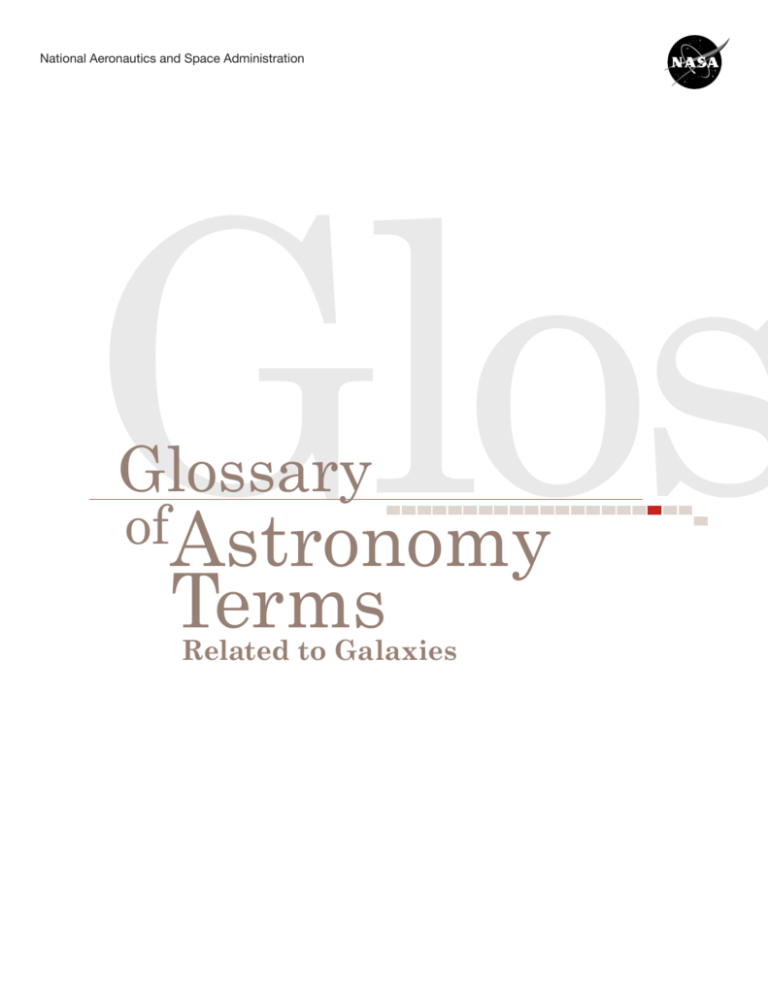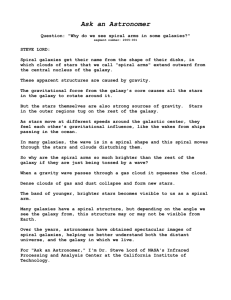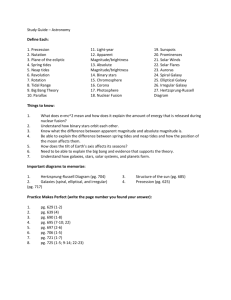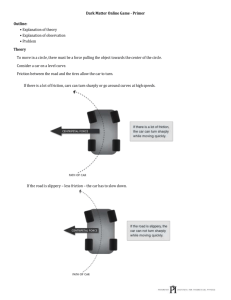Glossary of Astronomy Terms Related to Galaxies
advertisement

National Aeronautics and Space Administration Glos Glossary ofAstronomy Terms Related to Galaxies NAS A / Amazing S p a c e G l o s s a r y o f A s t r o n o m y Te r m s Asterism: A pattern formed by stars Compare/Contrast Chart or T-chart: A not recognized as one of the official 88 graphic organizer used to compare two objects constellations. Examples include the Summer or ideas. The objects are listed as headings Triangle, the Big Dipper, and the Winter at the top of two columns. The characteristics Circle. being compared are then listed under each heading. The chart’s top, horizontal line and Barred Spiral Galaxy: A type of spiral its center vertical line trace out the shape of galaxy having a linear extension, or “bar,” a “T.” made of stars and interstellar matter, passing through its center. Constellations: “Pictures” in the sky that ancient astronomers perceived by imagining Blue Star: A very hot star with a short lines or relations between stars that appear lifetime. Blue stars exist for a few million grouped. Often, mythological heroes or years. Sirius (Alpha Canis Majoris) is an creatures were the subjects of the pictures. example of a blue star. Creating the constellations in the sky not only provided stories for amusement, but Bulge: A rounded structure in the centers also helped people remember the positions of some galaxies, composed primarily of old of the stars. Knowing the positions of the stars, and having some gas and dust. The stars helped farmers keep track of the bulge of the Milky Way is about 10,000 light- seasons and travelers keep track of where years across. they were. Modern astronomers define 88 constellations, which are spread across the Colliding Galaxies: When two or more entire sky. galaxies are close enough, their gravity begins to attract each one toward the other. Disk: A pancake-shaped structure composed The attraction increases as the galaxies primarily of young and middle-aged stars, travel even closer together. These galaxies and having abundant gas and dust. Some old can collide and possibly merge to form an stars are also present. The disk surrounds elliptical galaxy. the bulge in a spiral galaxy. The disk in the NAS A / Amazing S p a c e G l o s s a r y o f A s t r o n o m y Te r m s Milky Way is 100,000 light-years across and not included in earlier catalogs, such as 2,000 light-years thick. those with numbers starting with “NGC” (designating John Dreyer’s New General Edge-on Spiral Galaxy: A spiral galaxy Catalogue of Nebulae and Clusters of Stars) or viewed from the side so that the disk “M” (designating Charles Messier’s Catalog of containing the spiral arms appears to be Nebulae and Star Clusters). a thin line of stars and dust crossing and extending beyond the bulge. Stars in the Face-on Spiral Galaxy: A spiral galaxy halo also may be visible. The spiral arm viewed from above so that the spiral arm structure is not visible when a spiral galaxy structure is visible. is viewed “edge-on.” Galaxy: A collection of a million to a trillion Elliptical Galaxy: A galaxy having an stars, along with gas and dust, all held elliptical shape. Some elliptical galaxies together by gravity. are nearly spherical, while others are more oblate, resembling footballs. An elliptical Halo: A roughly spherical collection of old galaxy is essentially a big bulge composed stars, clusters of old stars (called globular mostly of old stars and containing little clusters), and a little bit of gas and dust that interstellar matter (the gas and dust often extends farther than all other components of found in the space between stars). a galaxy. Halos contain dark matter, which is material that we cannot see but whose ESO: These letters, when followed by gravitational force can be measured. In the numbers, refer to the specific entries in Milky Way, the halo measures about 130,000 an archive of observations made by the light-years across. European Southern Observatory telescopes. Since the Hubble Space Telescope (HST) Hubble Deep Field: A long-exposure, optical- is a joint venture between NASA and the wavelength image. At the time it was taken, European Space Agency, ESO numbers it showed the sharpest views of the faintest are used to designate HST discoveries. galaxies ever seen. The image was made by Galaxies with ESO numbers are generally aiming the Hubble Space Telescope at a single NAS A / Amazing S p a c e G l o s s a r y o f A s t r o n o m y Te r m s piece of sky for 150 consecutive orbits. The Milky Way: The specific galaxy to which telescope made 342 exposures; 276 of them the Sun belongs, so named because many were fully processed and used for the image. of its stars appear as a milky band of light There are two Hubble Deep Field images — extending across the sky overhead, on a the first one studied a location in the northern clear, dark night. The Milky Way is a spiral sky (HDF–N) and the second one studied a galaxy. location in the southern sky (HDF–S). NGC: These letters, when followed by Hubble Space Telescope: An automated numbers, refer to specific entries in The telescope that orbits Earth at an altitude New General Catalogue of Nebulae and of 600 km (375 miles). The National Clusters of Stars, which was compiled Aeronautics and Space Administration by John L.E. Dreyer in the nineteenth and the European Space Agency built the century. This comprehensive list remains the telescope. Its primary mirror is 2.4 meters standard reference guide used by the world’s (94.5 inches) in diameter. The telescope astronomers. contains an array of instruments capable of carrying out a variety of high-quality Red Stars: Stars with low temperatures. astronomical observations at ultraviolet, Hydrogen-burning red stars are small optical, and infrared wavelengths. Because and use their available fuel slowly. These the telescope is above Earth’s atmosphere, it low-mass stars last for tens to hundreds can obtain extremely clear images. of billions of years — much longer than hotter-burning stars. Some red stars are Irregular Galaxy: A galaxy whose shape is very bright, which means they are also very neither elliptical nor spiral. It is often rich in large. These giants, or supergiants, are stars interstellar matter (gas and dust). nearing the ends of their lives. Betelgeuse (beta Orionis) is an example of a red Light-year: The distance traveled by light supergiant star. in a full year, equal to some 10 trillion kilometers (or about 6 trillion miles). NAS A / Amazing S p a c e G l o s s a r y o f A s t r o n o m y Te r m s Spiral Arms: Curved, pinwheel-like Venn Diagram: A diagram consisting of structures in the disk of a spiral galaxy. The two or more overlapping circles. It is often spiral arms contain blue stars and luminous used in mathematics to show relationships newborn stars that make their spiral pattern between sets. In other applications, Venn visible. diagrams are useful for examining similarities and differences in the characteristics of Spiral Galaxy: A galaxy made up of a disk, objects or ideas. spiral arms, and a bulge at its center. The size of the disk and the bulge vary. The galaxy Yellow Star: Stars that live for a medium is composed of a mixture of old and young length of time (about 10 billion years) and stars, as well as loose interstellar matter are neither extremely cool nor hot. Earth’s (the gas and dust found in the space Sun is an example of a yellow star. between stars).








